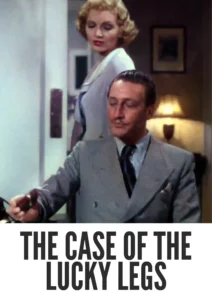Video Sources 0 Views

Synopsis
Detectives, Deception, and Dames: The Case of the Lucky Legs (1935) in Vivid Color

Dive into the thrilling world of the 1930s detective cinema with The Case of the Lucky Legs, a captivating blend of mystery and comedy, now beautifully colorized for a modern audience. This film features the charismatic Warren William as Perry Mason, embroiled in a case of fraud and beauty pageants. Perfect for fans of classic detective stories and those seeking a taste of Golden Age cinema, this HD download brings a vibrant twist to a beloved tale of crime and justice.
The Case of the Lucky Legs Storyline: A Perry Mason Mystery
The Case of the Lucky Legs plunges Perry Mason into the world of beauty contests and fraudulent schemes. When a contest winner turns up missing, Mason suspects foul play and begins to investigate.As Mason digs deeper, he uncovers a web of deceit involving crooked promoters, jealous rivals, and hidden agendas. With the help of his loyal secretary Della Street, Mason navigates the glamorous yet dangerous world of beauty pageants to uncover the truth behind the disappearance. The film is filled with witty banter, surprising twists, and the charm of Perry Mason as he outsmarts the criminals and brings justice to the innocent. Ultimately, The Case of the Lucky Legs is an entertaining and engaging mystery that showcases the early adventures of one of literature’s most iconic detectives.
Movie Cast
The film features a talented cast who bring this thrilling story to life:
- Warren William as Perry Mason
- Patricia Ellis as Della Street
- Genevieve Tobin as Eva Reiner
- Lyle Talbot as Drake
- Porter Hall as Arthur Reiner
Movie Genre
The Case of the Lucky Legs falls into the genre of hardboiled detective film, blending elements of mystery, comedy, and legal drama. Its fast-paced plot and witty dialogue make it an entertaining and engaging film.
Historical Context: Perry Mason and Early Detective Films
Released in 1935, The Case of the Lucky Legs is part of a series of films featuring Erle Stanley Gardner’s famous character Perry Mason. These films were produced during a period when detective stories were gaining popularity in both literature and cinema. The Case of the Lucky Legs reflects the style and themes of early detective films, showcasing the ingenuity and charisma of Perry Mason.
Colorization Details
This colorized version of The Case of the Lucky Legs has been meticulously restored using modern digital techniques, enhancing the visual appeal while preserving the film’s original atmosphere of mystery and suspense. The colorization process involved carefully analyzing the grayscale tones of the original black and white footage and assigning appropriate colors to each scene. While the specific software used remains proprietary, the techniques employed included advanced algorithms for color palette selection and image enhancement. This painstaking process brings new life to the characters and settings, making the story even more engaging for modern audiences. While some may debate the merits of colorizing classic films, it introduces these films to a broader audience, ensuring their legacy for future generations.
Technical Details
- Director: Archie Mayo
- Screenplay: Ben Markson, Erle Stanley Gardner (novel)
- Cinematography: Arthur L. Todd
- Edited by: James Gibbon
- Production Company: Warner Bros.
- Distributed by: Warner Bros.
- Runtime: 77 minutes
Technical Specifications
- Download Format: MP4
- Resolution: HD (1080p)
- Compatibility: Compatible with most devices, including smartphones, tablets, computers, and smart TVs.
Reviews and Critical Reception
The Case of the Lucky Legs (1935) is a notable entry in the Perry Mason film series, showcasing the character’s early adventures. The film is appreciated for its fast-paced plot, witty dialogue, and the charismatic performance of Warren William as Perry Mason.
FAQs
- Q: What is The Case of the Lucky Legs about?
- A: The Case of the Lucky Legs is a detective story about Perry Mason investigating a beauty contest scam and a missing winner.
- Q: Is The Case of the Lucky Legs (1935) a well-known Perry Mason film?
- A: The Case of the Lucky Legs is a notable film in the Perry Mason series, featuring Warren William as the famous detective.
- Q: Is this version of The Case of the Lucky Legs colorized?
- A: Yes, this version has been professionally colorized to enhance the viewing experience.
- Q: What makes The Case of the Lucky Legs interesting for detective film fans?
- A: The Case of the Lucky Legs offers a glimpse into the early adventures of Perry Mason, showcasing his wit and ingenuity.
- Q: What is the download format?
- A: The download format is MP4, which is compatible with most devices.
- Q: What resolution is the download?
- A: The resolution is HD (1080p), providing a high-quality viewing experience.
Download Now in HD!
Watch The Case of the Lucky Legs Today!











